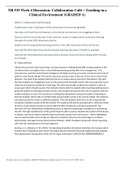Other
NR 535 Week 4 Discussion: Collaboration Café – Teaching in a Clinical Environment (GRADED A)
- Course
- Institution
NR 535 Week 4 Discussion: Collaboration Café – Teaching in a Clinical Environment (GRADED A) Week 5: Collaboration Café (Graded) Collaboration Cafe: Teaching in a Skills Laboratory Environment (graded) Describe a skill with that the learners in the clinical environment are struggling to learn. ...
[Show more]



